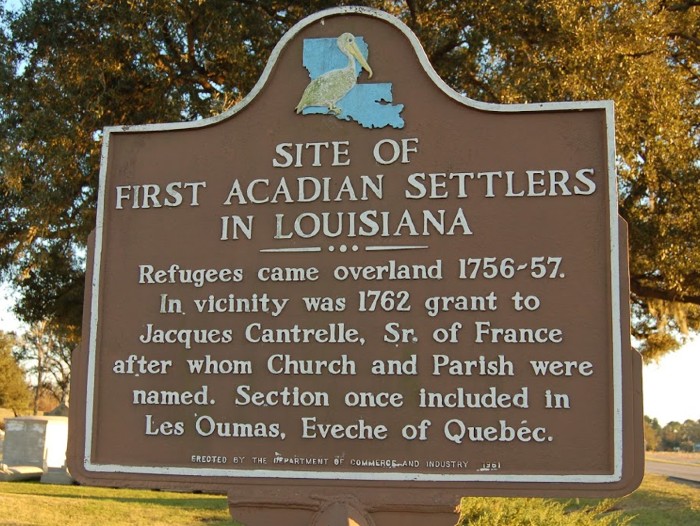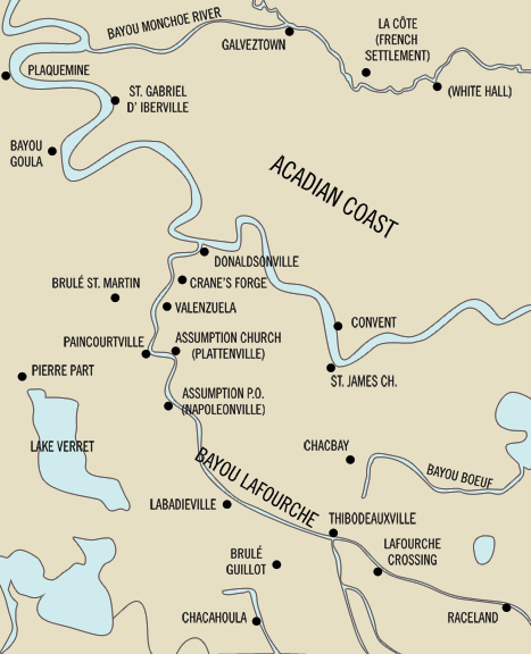St. James Parish is part of the “Acadian Coast” which is the name given by history to the stretch of the Mississippi River colonized by Acadians established in Louisiana since 1764 who became Cajuns over time. Soon after, the Acadian migrants arrived in successive waves until 1795.
In front of the community of Convent which is today the parish seat of St. James Parish, there is on the opposite bank of the Mississippi river a historical plaque indicating that the first Acadian settlers arrived in Louisiana by land in 1756-57. They would have crossed the Appalachians by following the Native American trails which crossed the mountains separating at the time New France from the Anglo-American colonies. Unfortunately, no documentation of their adventures exists. It was in proximity to this site that agricultural lands were conceded to Jacques (James in English) Cantrelle in 1762, after whom the parish was named. It is worthy of note that the parish of “Saint-Jacques de Cabanocée” was part of the episcopal territory named Les Oumas of the bishopric of Québec.
Jacques Cantrelle, a Frenchman from New Orleans, as well as Nicolas-Pierre Verret, commander at Cabanocée, were instructed by the outgoing French governor, Blaise d’Abbadie, to welcome and help the Acadians settle in their adopted country. The colorful legends of Louisiana tell us that the word Cabanocée means “duck hut” in the language of the Native Americans. One can imagine that Jacques Cartier in 1534 could also have interpreted the indigenous word “kanata” to mean “my cabin in Canada” or perhaps “place where our huts are” or “this is our village”. We shall never know…
The pioneers of Cabanocée
Jacques Cantrelle, originally from Picardy, France, became a planter in Louisiana. He named his plantation Cabanocée after the aboriginal name of a bayou (i.e., a branch of the Mississippi) in the area. The plantation’s day-to-day operations were managed on site by his son-in-law, Nicolas-Pierre Verret who married Marie Cantrelle in 1750.
The first documented wave of Acadian migrants arrived in New Orleans in February 1764. It was made up of about twenty people, including several children, belonging to four families. They came from Georgia via Mobile (today in Alabama). The Georgia Gazette reported on December 22, 1763: “Yesterday more of the Acadians in number about 21, went in a vessel for Mobile, from which place they are to go to New Orleans”. Indeed, the ship Savannah Packet departed Savannah, Georgia to Mobile in the afternoon of December 21st.
According to recorded naming, this first group of Acadians included:
- Jean-Baptiste Cormier and his wife Madeleine Richard and their five daughters, namely Madeleine, Marie, Marie-Anne, Marguerite and Anastasie;
- Jean Richard and his wife Catherine Cormier and their three children, Jean-Marie (the oldest), Rosalie and Joseph; the two youngest were born in Georgia;
- Olivier Landry and his wife Cécile Poirier and their three children, Joseph and Marie (born in Chignectou, Acadia) and Jean-Antoine born in Georgia;
- Jean Poirier and his wife Marie-Madeleine Richard and their two sons, Joseph and Jean-Baptiste, both born in Georgia.
With the exception of the five Georgia-born children, they were all from the isthmus of Chignectou in Acadia. It is of importance to mention them all here because they represent together the genesis of today’s profoundly renewed Acadia.
The following four inscriptions in the baptismal register of Saint-Louis Church in New Orleans for the year 1764 do attest that these Acadian families undoubtedly reached Louisiana: Joseph Poirier, Jean-Antoine Landry and Joseph Richard were baptized on February 26, 1764, while Jean-Baptiste Poirier’s baptism took place March 1, 1764 (source: New Orleans Sacramental Acts, volume 2, 1751-1771).



